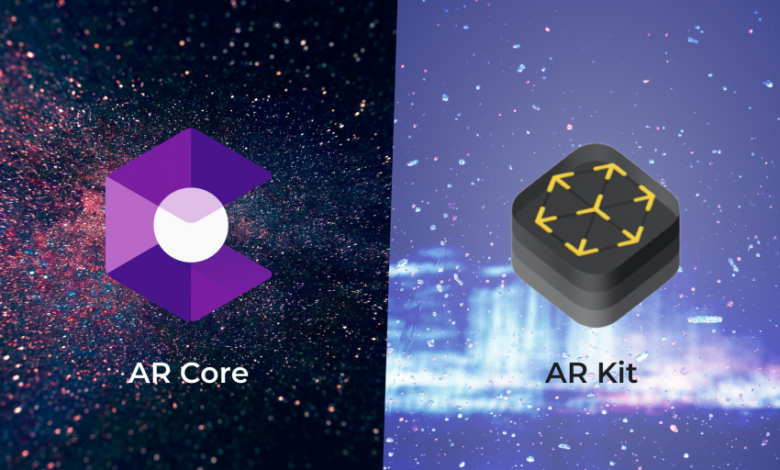ARCore and ARKit: Realizing the Relationship between the Two AR Platforms

Introduction
Augmented Reality (AR) has become the most effective and efficient way to know how technical evolution is changing the world and bridging the gap between the physical and the digital worlds. It enables us with the breathtaking real-life experience of overlaying virtual objects onto the natural environment and allows for interactive and immersive encounters. According to Wikipedia, AR incorporates three fundamental features: a combination of the real and virtual worlds, real-time interaction, and the accurate 3D registration of the real and virtual objects.
However, considering AR, the two most prominent names complementary to the AR realm are the ‘ARCore’, developed by Google, and ‘ARKit’, developed by Apple. Both these platforms are instrumental in driving AR adoption across millions of devices worldwide. Therefore, in this blog post, we will explore the all-around aspects of the relationship between the two and will compare both on various aspects along with their contribution to the growth of AR in real life.
What is ARCore?
ARCore is an AR framework by Google (2017) designed to bring AR experiences to Android devices. ARCore utilizes a combination of motion tracking, environmental understanding, and light estimation to enable the placement of virtual objects into real-world scenarios.
It offers the product owners tools and APIs that help create various Augmented Reality applications, including eCommerce, gaming, education, and more. The ARCore also supports various Android devices to democratize AR technology and reach a worldwide audience.
Fundamental Features of ARCore
Regarding features, Google’s AR framework ARCore offers several exceptional features that make it stand out from ARKit. Initially, the core factor that instills many features into the application is the Google Play Services, which offers positional tracking without needing a connected device or extra hardware on the mobile device. It enables Google to roll out or introduce several new features and improvements without waiting for the manufacturers to update their devices. Thus, making the development more accessible and efficient means the product owners get more time to spend and focus on other things instead of worrying about how their code will run on various operating systems and devices. A few of the prominent features of ARCore are:
- Motion Tracking
- Anchoring Objects
- Environmental Understanding
- Light Estimation
- User Interaction
What is ARKit?
ARKit, as mentioned above, is a framework developed by Apple and was introduced in 2017 to enable product owners to create the AR experience for iOS devices. The ARKit leverages advanced computer vision techniques to keep track of the environment, detect features, and effectively integrate virtual content into the real world.
This framework provides the developers with robust tools, such as SceneKit and RealityKit, for building interactive and realistic Augmented Reality applications. ARKit supports and is available on many Apple devices, making it accessible to a significant portion of iOS users.
Fundamental Features of ARKit
The foremost and most prominent feature of ARKit is its close integration with iOS, the extensive developer community, and its power efficiency. It is also amongst the few platforms that enable rendering images in 3D space without requiring a depth sensor or marker, like the ones found in HoloLens, or Magic Leap. These factors and Apple’s expertise in designing hardware and software as an integrated system make producing high-quality experiences on Apple mobile devices or iPhones easier. Talking about a few features of ARKit, it offers the ones as:
- Tracking
- Landscape Understanding
- Light Estimation
- AR Rendering
Did You Know?
After years of hesitance, speculations, and anticipations, Apple has kept its foot in an all-new category of spatial computing with its latest AR headset. It introduced the Apple Vision Pro on 5 June 2023, seamlessly blending augmented, virtual, and physical reality. According to Apple, the Apple VIsion Pro Creates a canvas for apps that scales beyond the boundaries of traditional displays and enables you to control all of it through your eyes, hands, and at your fingertips.
Though the Apple Vision Pro is presented as an AR device, it can switch between Augmented and Full Reality using a dial. Also, stepping forward into the world of AR and VR, and to complement the Vision Pro, Apple has also introduced its new operating system called VisionOS, making this device controller free, allowing you to browse rows of app icons. It is definitely the initiation of a new era of technological advancements, where the users, as well as the business owners, are all inclining to the paradigms of the world of AR and VR.
The Relationship between ARCore and ARKit
We now have a brief overview of the ARCore and ARKit platforms and their features. We understand that these SDKs offer exceptional AR functionality, and many frameworks contribute to bringing AR functionalities into Android and iOS. Out of those available frameworks, the AR Apps with Flutter allow for exceptional functionalities and features in their web application. Moving forward, let us now understand the relationship between these frameworks on various parameters.
Universal Acceptability
Though ARCore and ARKit are developed by the ever-renowned rivals Google and Apple, they share common goals. Initially, to make the AR technology universally accessible through frameworks for the product owners, make the AR experiences accessible to a wide range of users, and lower the entry barriers, both Google and Apple have created a vibrant AR ecosystem, encouraging innovation and compelling Augmented Experiences.
Upscaling the User Experience
The ARKit and ARCore both focus more on enhancing the overall user experience. These frameworks offer similar core features, including motion tracking, place detection, and light estimation, enabling product owners to create immersive and realistic AR interactions. Leveraging the device sensors and cameras, ARCore and ARKit offer precise object positioning, effectively and efficiently integrating virtual content into the physical world effectively and efficiently. Visit Naa Songs to find out more information
Different Implementations and Ecosystems
Both ARCore and ARKit have unique tools and APIs for the developers. However, regarding implementations and ecosystems, ARCore supports a wide range of Android devices, catering to diverse hardware landscapes. Also, the ARCore has integration support with the Google ecosystem that allows for exceptional collaboration with other Google services and platforms. In contrast, ARKit is restrained to Apple’s iOS devices, delivering a more controlled and standardized environment for the product owners. And this tight integration with the Apple ecosystem enables the product owners to leverage the capabilities of iOS, such as Maps, Siri, and CoreML.
Collaboration and Cross-Platform Integration
As both Google and Apple recognize the growing importance of the user experience within their separate ecosystems, thus, catering to this and recognizing the potential benefits of collaboration, Google and Apple have taken steps to enable cross-platform functionality within the AR experiences. In 2019, they announced a collaboration between the ARCore and ARKit, establishing a standard file format for AR content called the Open AR Cloud Anchor. This initiative allowed the developers to create AR experiences that can be shared and are accessible across both platforms to promote interoperability and expand the reach of the AR applications.
Conclusion
With this, we can conclude that ARCore and ARKit both play a significant role in the extensive growth of the Augmented Reality interface. Both these frameworks intend for a similar objective: to empower the developers and offer users immersive experiences. Whereby, Apple ARKit has the advantage in the form of the consumer market and hardware value, and the Google ARCore has the advantage of worldwide accessibility and mapping. These SDKs offer great assistance in Augmented Reality to creating breathtaking AR applications. However, suppose you are also a business owner and are confused about the benefits of the Flutter AR applications. In that case, you can Hire Flutter Developers to help you guide through the process and assist you throughout your AR Apps with Flutter development.
Author Bio:
Chandresh Patel is a CEO, Agile coach, and founder of Bacancy Technology. His truly entrepreneurial spirit, skillful expertise, and extensive knowledge in Agile software development services have helped the organization to achieve new heights of success. Chandresh is fronting the organization into global markets in a systematic, innovative, and collaborative way to fulfill custom software development needs and provide optimum quality.





